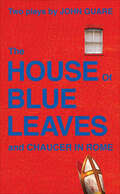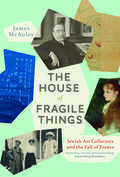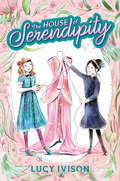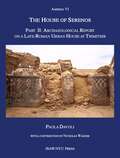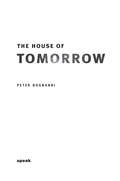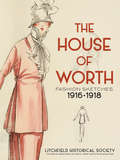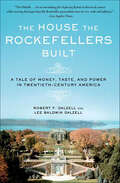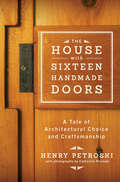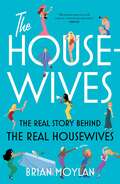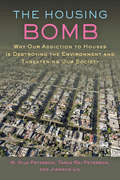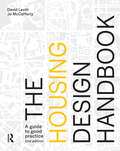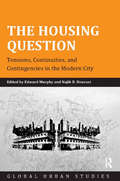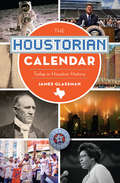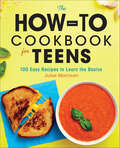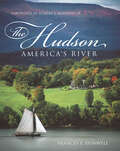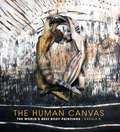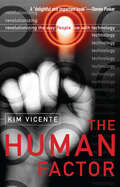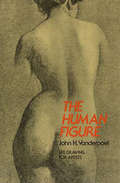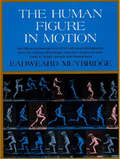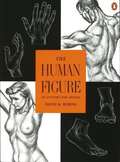- Table View
- List View
The House of Blue Leaves and Chaucer in Rome: Two Plays
by John GuareFrom an American playwright who “is in a class by himself,” two acclaimed plays linked by a character who comes of age in the sixties. (The New York Times)In John Guare’s classic play The House of Blue Leaves, winner of the New York Drama Critics Circle Award for best play, the Pope is visiting New York, and eighteen-year-old Ronnie goes AWOL from the army to come home to New York and blow up the Pope as he passes his house. In his new play, Chaucer in Rome, it is the year 2000, and Ron and his wife come to Rome to search for their son. With his inimitable wit and understanding, Guare has written two scathingly funny satires on the warping hunger for fame, and the betrayal involved in creating art.Praise for The House of Blue Leaves:“Splendid . . . a joyful affirmation of life and of John Guare’s artistry.” —The New York Times“A woozy, fragile, hilarious heartbreaker . . . the writing is lush with sad, ironic wisdom about fame, love, and deluded values.” —USA TodayPraise for Chaucer in Rome:“Guare makes us become voyeurs even as we scorn voyeurism—thus offering a titillating, troubling commentary on life.” —USA Today“Guare’s most disciplined, merciless yet lovable work since Six Degrees of Separation and maybe his best yet.” —New York Newsday
The House of Fragile Things: Jewish Art Collectors and the Fall of France
by James McAuleyA powerful history of Jewish art collectors in France, and how an embrace of art and beauty was met with hatred and destruction&“Alluring and disturbing. . . . The depths of French anti-Semitism is the stunning subject that Mr. McAuley lays bare. . . . [He] tells this haunting saga in eloquent detail. As French anti-Semitism rises once again today, the effect is nothing less than chilling.&”—Diane Cole, Wall Street Journal In the dramatic years between 1870 and the end of World War II, a number of prominent French Jews—pillars of an embattled community—invested their fortunes in France&’s cultural artifacts, sacrificed their sons to the country&’s army, and were ultimately rewarded by seeing their collections plundered and their families deported to Nazi concentration camps. In this rich, evocative account, James McAuley explores the central role that art and material culture played in the assimilation and identity of French Jews in the fin-de-siècle. Weaving together narratives of various figures, some familiar from the works of Marcel Proust and the diaries of Jules and Edmond Goncourt—the Camondos, the Rothschilds, the Ephrussis, the Cahens d'Anvers—McAuley shows how Jewish art collectors contended with a powerful strain of anti-Semitism: they were often accused of &“invading&” France&’s cultural patrimony. The collections these families left behind—many ultimately donated to the French state—were their response, tragic attempts to celebrate a nation that later betrayed them.
The House of Serendipity (The House of Serendipity #1)
by Lucy IvisonFans of Shannon Hale's Princess Academy series and budding fashionistas everywhere will love this charming, delightful middle-grade novel about two girls with a talent for dressmaking set in 1920s London. <p><p> The perfect dress can change everything. When talented young tailor Myrtle Mathers becomes a maid for the Cartwright family, she thinks her days of sketching and stitching are over for good. That is, until Sylvia Cartwright runs into a big problem--her older sister's debutante ball is about to be ruined by a truly horrendous dress. Desperate, Sylvia calls on Myrtle to help her save the night, and a serendipitous partnership begins. <p><p> Their design catches the eye of London's debutantes, so when one practically begs Myrtle and Sylvia to dress her, the two girls make a plan: create something special for her without revealing their true identities. If people find out what Myrtle and Sylvia are up to, it could spell disaster for the girls' futures. <p><p> But as it turns out, the debutante is looking for more than just a gorgeous outfit--she needs a disguise that will help her escape high-society life forever. And for Myrtle and Sylvia, what starts as a plan to prove their design skills soon becomes a secret mission to defy expectations. <p><p> A fabulous, fantastical adventure through 1920s London, this delightful series opener celebrates the magic of friendship, fashion, and being yourself.
The House of Serenos, Part II: Archaeological Report on a Late-Roman Urban House at Trimithis (Amheida VI) (ISAW Monographs #15)
by Paola DavoliA comprehensive study of the archaeology of the House of SerenosThe House of Serenos, Part II is the second of four books devoted to publishing the archaeology of the House of Serenos, a richly decorated, late antique villa of a local élite, located in Amheida (ancient Trimithis) in the Dakhla Oasis of Egypt. The House of Serenos, Part II synthesizes the archaeological information presented in detail in other volumes in a comprehensive study of the architectural and archaeological history of the house and its relationship to its natural and built environments, from construction through expansion and renovation to its eventual abandonment around the end of the fourth century. The volume includes discussions of archaeological method, stratigraphy, architecture, and the archaeological assemblages discovered in the House of Serenos—and reveals what all this can tell us about the inhabitants and their experience living in this high-status residence at the edge of the Roman Empire.
The House of Tomorrow
by Peter Bognanni* "Funny and unique . . . An honest, noisy, and raucous look at friendship and how loud music can make almost everything better." --Publishers Weekly, starred reviewSebastian Prendergast lives with his eccentric grandmother in a geodesic dome. His homeschooling has taught him much-but he's learned little about girls, junk food, or loud, angry music. Then fate casts Sebastian out of the dome, and he finds a different kind of tutor in Jared Whitcomb: a chain-smoking sixteen-year-old heart transplant recipient who teaches him the ways of rebellion. Together they form a punk band and plan to take the local church talent show by storm. But when his grandmother calls him back to the futurist life she has planned for him, he must decide whether to answer the call-or start a future of his own.
The House of Worth: Fashion Sketches, 1916-1918
by Michael Krass Litchfield Historical Society Karen M. Depauw Jessica D. Jenkins"In-depth research on the House of Worth, with many fabulous photographs of the drawings from the designers, with hand-written notations and fabric swatches." -- Jefferson-Madison Regional Library System"Beautiful. A must for any clothing lover or historian." -- The Walters Art MuseumThis stylish compilation features 125 watercolor and ink renderings of designs from the house of Worth, the first couturier establishment and founder of the modern fashion industry. Sent to one of their clients, a seasonal resident in Litchfield, Connecticut, the sketches include fabric swatches, design names, detailed price information, and personalized notes. The catalog includes two substantial essays that address the cultural and social significance of both the house of Worth sketches and the town of Litchfield. The first item introduces the town during the early twentieth century and the residents associated with the sketches, Julia Chester Wells and Mary Perkins Quincy. The second essay profiles the house of Worth in the 1910s, focusing on the sketches and their place within the broader history of fashion and noting social shifts and changes in fashion consumption. The final segment includes images of all 125 sketches, accompanied by twenty annotations that offer in-depth explorations of common themes such as historic design influences and ethnic inspiration. Published in conjunction with an exhibition at the Litchfield Historical Society, this volume is a source of interest and inspiration to individuals from fashion historians to costume designers.
The House on First Street: My New Orleans Story
by Julia Reed“Reed recounts with humor [post Katrina] home-improvement nightmares in a story that is part ‘Money Pitt’ and part love letter to her adopted home town.” —Washington Post, Front Page FeatureAfter fifteen years of living like a vagabond on her reporter's schedule, Julia Reed got married and bought a house in the historic Garden District of New Orleans. Four weeks after she moved in, Hurricane Katrina struck. Rich with sumptuous details and with the author's trademark humor, The House on First Street is the chronicle of a remarkable and often hilarious homecoming, as well as a thoroughly original tribute to our country's most original city.“What emerges from a heartrending, soul-stirring, rib-tickling and palate-prickling banquet of details is why Ms. Reed cannot leave New Orleans: love. It’s an undeceived devotion to a place and particularity that is admirable, and almost astonishing, in our increasingly deracinated culture.” —Wall Street Journal“Reed shares this sliver of her life with a light, conversational tone, and though somewhat tangential, she conveys the richness of pace and flavor of the Big Easy as life gets back to ‘normal’ without pretense.” —Christian Science Monitor “Reed is a breezy writer who nicely captures the despair and elation of seeing the city slowly come back to life.” —Chicago Sun-Times“With her usual keen eye for the quirky and outrageous, Reed finds much to amuse the reader in this delightful volume.” —Cokie Roberts, ABC and NPR News, author of Ladies of Liberty“With great literary panache and a throaty humor, Julia Reed captures the magical allure of the city, its food and its people . . . destined to be a classic.” —Walter Issacson, bestselling author of Einstein and Elon Musk
The House the Rockefellers Built: A Tale of Money, Taste, and Power in Twentieth-Century America
by Robert F. Dalzell Lee Baldwin DalzellWhat it was like to be as rich as Rockefeller: How a house gave shape and meaning to three generations of an iconic American familyOne hundred years ago America's richest man established a dynastic seat, the granite-clad Kykuit, high above the Hudson River. Though George Vanderbilt's 255-room Biltmore had recently put the American country house on the money map, John D. Rockefeller, who detested ostentation, had something simple in mind—at least until his son John Jr. and his charming wife, Abby, injected a spirit of noblesse oblige into the equation. Built to honor the senior Rockefeller, the house would also become the place above all others that anchored the family's memories. There could never be a better picture of the Rockefellers and their ambitions for the enormous fortune Senior had settled upon them. The authors take us inside the house and the family to observe a century of building and rebuilding—the ebb and flow of events and family feelings, the architecture and furnishings, the art and the gardens. A complex saga, The House the Rockefellers Built is alive with surprising twists and turns that reveal the tastes of a large family often sharply at odds with one another about the fortune the house symbolized.
The House with Sixteen Handmade Doors: A Tale of Architectural Choice and Craftsmanship
by Henry Petroski Catherine PetroskiAn architectural whodunit that unlocks the secrets of a hand-built home. When Henry Petroski and his wife Catherine bought a charming but modest six-decades-old island retreat in coastal Maine, Petroski couldn't help but admire its unusual construction. An eminent expert on engineering, history, and design, he began wondering about the place's origins and evolution: Who built it, and how? What needs, materials, technologies, historical developments, and laws shaped it? How had it fared through the years with its various inhabitants? Sleuthing around dimly lit closets, knotty-pine wall panels, and even a secret passage--but never removing so much as a nail--Petroski zooms in on the details but also steps back to examine the structure in the context of its time and place. Catherine Petroski's beautiful photographs capture the clues and the atmosphere. A vibrant cast of neighbors and past residents--most notably the house's masterful creator, an engineer-turned-"folk architect"--become key characters in the story. As the mystery unfolds, revealing an extraordinary house and its environs, this ode to loving design will leave readers enchanted and inspired.
The Housewives: The Real Story Behind the Real Housewives
by Brian MoylanFrom Brian Moylan, the writer of Vulture’s legendary Real Housewives recaps, a table-flipping, finger-pointing, halter-topping VIP journey through reality TV’s greatest saga… <P><P>In the spring of 2006, a new kind of show premiered on Bravo: The Real Housewives of Orange County. Its stars were tanned, taut, and bedazzled; their homes were echoey California villas; and their drama was gossip-fueled, wine-drenched, and absolutely exquisite. <P><P>Fifteen seasons on, RHOC is an institution, along with The Real Housewives of New York, Atlanta, New Jersey, Miami, Potomac, and more. Over the years these ladies have done a lot more than lunch, launching thirty-one books, a cocktail line, two jail sentences, a couple supermodel daughters, Andy Cohen’s talk show career, thirty-six divorces, fourteen albums, a White House party crash, and approximately one million memes. <P><P>Brian Moylan has been there through it all, in front of the screen and behind the scenes. The writer of Vulture’s beloved series recaps, he’s here to tell us the full story, from the inside scoop on every classic throwdown to the questions we’ve always wanted to know, like—what are the housewives really like off-camera? (The same.) How much money do they make? (Lots.) He has a lot to say about the legacy and fandom of a franchise that’s near and dear to his heart, and inextricable from pop culture today. <P><P>A must-have for any fan of real drama and fake [redacted], The Housewives is the definitive companion to an American TV treasure. <P><P><b>A New York Times Best Seller</b>
The Housing Bomb: Why Our Addiction to Houses Is Destroying the Environment and Threatening Our Society
by Jianguo Liu M. Nils Peterson Tarla PetersonHow our thirst for more and larger houses is undermining society and what we can do about it.Have we built our way to ruin? Is your desire for that beach house or cabin in the woods part of the environmental crisis? Do you really need a bigger home? Why don’t multiple generations still live under one roof? In The Housing Bomb, leading environmental researchers M. Nils Peterson, Tarla Rai Peterson, and Jianguo Liu sound the alarm, explaining how and why our growing addiction to houses has taken the humble American dream and twisted it into an environmental and societal nightmare. Without realizing how much a contemporary home already contributes to environmental destruction, most of us want bigger and bigger houses and dream of the day when we own not just one dwelling but at least the two our neighbor does. We push our children to "get out on their own" long before they need to, creating a second household where previously one existed. We pave and build, demolishing habitat needed by threatened and endangered species, adding to the mounting burden of global climate change, and sucking away resources much better applied to pressing societal needs. "Reduce, reuse, recycle" is seldom evoked in the housing world, where economists predict financial disasters when "new housing starts" decline and the idea of renovating inner city residences is regarded as merely a good cause. Presenting irrefutable evidence, this book cries out for America and the world to intervene by making simple changes in our household energy and water usage and by supporting municipal, state, national, and international policies to counter this devastation and overuse of resources. It offers a way out of the mess we are creating and envisions a future where we all live comfortable, nondestructive lives. The "housing bomb" is ticking, and our choice is clear—change our approach or feel the blast.
The Housing Design Handbook: A Guide to Good Practice
by David Levitt Jo McCaffertyEveryone deserves a decent and affordable home, a truth (almost) universally acknowledged. But housing in the UK has been in a state of crisis for decades, with too few homes built, too often of dubious quality, and costing too much to buy, rent or inhabit. It doesn’t have to be like this. Bringing together a wealth of experience from a wide range of housing experts, this completely revised edition of The Housing Design Handbook provides an authoritative, comprehensive and systematic guide to best practice in what is perhaps the most contentious and complex field of architectural design. This book sets out design principles for all the essential components of successful housing design – including placemaking, typologies and density, internal and external space, privacy, security, tenure, and community engagement – illustrated with case studies of schemes by architecture practices working across the UK and continental Europe. Written by David Levitt and Jo McCafferty – two recognised authorities in the field – and with contributions from more than twenty other leading practitioners, The Housing Design Handbook is an essential reference for professionals and students in architecture and design as well as for government bodies, housing associations and other agencies involved in housing.
The Housing Question: Tensions, Continuities, and Contingencies in the Modern City (Global Urban Studies)
by Edward Murphy Najib B. HouraniIn the wake of the Great Recession, housing and its financing suddenly re-emerged as questions of significant public concern. Yet both public and academic debates about housing have remained constricted, tending not to explore how the evolution of housing simultaneously entails basic forms of socio-spatial reproduction and underlying tensions in the political order. Drawing on cutting edge perspectives from urban studies, this book grants renewed, interdisciplinary energy to the housing question. It explores how housing raises a series of vexing issues surrounding rights, identity, and justice in the modern city. Through finely detailed studies that illuminate national and regional particularities- ranging from analyses of urban planning in the Soviet Union, the post-Katrina reconstruction of New Orleans, to squatting in contemporary Lima - the volume underscores how housing questions matter in a wide range of contexts. It draws attention to ruptures and continuities between high modernist and neoliberal forms of urbanism, demonstrating how housing and the dilemmas surrounding it are central to governance and the production of space in a rapidly urbanizing world.
The Houstorian Calendar: Today in Houston History (On This Day In)
by James GlassmanSeptember 4, 2000, was Houston's hottest day on record, as well as Beyoncé's nineteenth birthday. Sam Houston was elected president on September 5, 1836. The city was awarded a National League baseball franchise on October 17, 1960, and on November 1, 2017, the Astros won their first World Series. On December 13, 1882, the Capitol Hotel became Houston's first public building to get electricity. Tragedy struck on April 16, 1947, when a ship carrying ammonium nitrate fertilizer exploded alongside a Texas City dock. James Glassman captures every single day of the year in the prism of Houston history, from the Texas Revolution to the moon landing.
The How-To Cookbook for Teens: 100 Easy Recipes to Learn the Basics
by Julee MorrisonGive teens the gift of delicious, balanced meals they can make from scratch!Learning how to cook is a fun, creative outlet that also teaches an essential life skill. With simple recipes and step-by-step instructions, this introductory cookbook for teenagers guides young chefs-to-be through their first time in the kitchen, all the way through cooking full, flavorful meals for the whole family.Give your teen the tools to feed themselves balanced meals with a teen cookbook that includes:Teen-friendly foods—Your teen will discover 100 tasty and familiar recipes like Nachos, Sloppy Joes, Easy Shrimp Scampi, and Mustard and Maple-Glazed Chicken.Cooking fundamentals—For teens just starting out, this basic cookbook teaches all the key skills, with instruction on food safety, common cooking techniques, reading a recipe, and cleaning up.Room to experiment—Each recipe includes space to write down new ingredients to try so teens can experiment with flavors and textures and learn what worked (and what didn't!).Turn your teen into a culinary whiz with a starter cookbook written just for them.
The Hudson: America's River
by Frances DunwellFrances F. Dunwell presents a rich portrait of the Hudson and of the visionary people whose deep relationship with the river inspires changes in American history and culture. Lavishly illustrated with color plates of Hudson River School paintings, period engravings, and glass plate photography, The Hudson captures the spirit of the river through the eyes of its many admirers. It shows the crucial role of the Hudson in the shaping of Manhattan, the rise of the Empire State, and the trajectory of world trade and global politics, as well as the river's influence on art and architecture, engineering, and conservation.
The Hudson: America's River
by Frances F. Dunwell&“A commanding and inspiring biography of a river that gave rise to an art movement, progressive social quests, [and] landmark environmental cases.&” —Booklist (starred review) Includes maps, photos, and illustrations Frances F. Dunwell presents a rich portrait of the Hudson and of the visionary people whose deep relationship with the river inspired changes in American history and culture. Lavishly illustrated with color plates of Hudson River School paintings, period engravings, and glass plate photography, The Hudson captures the spirit of the river through the eyes of its many admirers. It reveals the crucial role of the Hudson in the shaping of Manhattan, the rise of the Empire State, and the trajectory of world trade and global politics, as well as the river&’s influence on art and architecture, engineering, and conservation. &“A story of interaction between people and the environment and a story of continuing inspiration and renewal.&” —Library Journal
The Human Canvas: The World's Best Body Paintings
by Karala Barendregt"The human body is the most beautiful thing to us, both inside and out." --Nick & Brian Wolfe Inside the Magical World of Bodypainting From fine art to fashion and from advertising to competition, the world of bodypainting is vast and beautiful. With The Human Canvas you will get front row seats to the pageantry of mind-blowing images from accomplished artists around the world. Many of these artists have won the coveted championship at the World Bodypainting Festival and every one holds a special place within this secret, joyful world of creativity and art. With gorgeous images and inside peeks into the minds and processes of the artists, this book will inspire and amaze you. This book was inspired by the World Champion artists Brian Wolfe, who succumbed in his fight against pancreatic cancer in October 2013. A portion of the proceeds from this project will go to support Brian Wolfe's wife and young daughter. About the World Bodypainting Festival The World Bodypainting Festival in Austria has been one of the driving forces in bodypainting over the past two decades. This event hosts the World Bodypainting Championships and has distinguished and encouraged the art form. Receiving hundreds of hours of broadcast time each year, the World Bodypainting Festival has carried this art form into the consciousness of everyday people on almost every continent. It has brought together a massive artistic community with years of history, creativity and experience. "Imagine a painter who can create an image from an idea in the fullness of color, design and expression, and then imagine this artist asking their canvas to sing, dance or scream." --Karala B.
The Human City: Urbanism for the Rest of Us
by Joel KotkinThe author of The Coming of Neo-Feudalism and The New Class Conflict challenges conventions of urban planning. Around the globe, most new urban development has adhered to similar tenets: tall structures, small units, and high density. In The Human City, Joel Kotkin―called &“America&’s uber-geographer&” by David Brooks of the New York Times―questions these nearly ubiquitous practices, suggesting that they do not consider the needs and desires of the vast majority of people. Built environments, Kotkin argues, must reflect the preferences of most people―even if that means lower-density development. The Human City ponders the purpose of the city and investigates the factors that drive most urban development today. Armed with his own astute research, a deep-seated knowledge of urban history, and a sound grasp of economic, political, and social trends, Kotkin pokes holes in what he calls the &“retro-urbanist&” ideology and offers a refreshing case for dispersion centered on human values. This book is not anti-urban, but it does advocate a greater range of options for people to live the way they want at all stages of their lives.Praise for The Human City &“Kotkin . . . presents the most cogent, evidence-based and clear-headed exposition of the pro-suburban argument . . . . In pithy, readable sections, each addressing a single issue, he debunks one attack on the suburbs after another. But he does more than that. He weaves an impressive array of original observations about cities into his arguments, enriching our understanding of what cities are about and what they can and must become.&” —Shlomo Angel, Wall Street Journal &“The most eloquent expression of urbanism since Jane Jacobs&’s The Death and Life of Great American Cities. Kotkin writes with a strong sense of place; he recognizes that the geography and traditions of a city create the contours of its urbanity.&” —Ronnie Wachter, Chicago Tribune
The Human Essence: The Sources of Science and Art
by George ThomsonThis book is a short introduction to Marxism that addresses its political, historical and ideological aspects of science and art.
The Human Factor: Revolutionizing the Way People Live with Technology
by Kim J. VicenteIn this incessantly readable, groundbreaking work, Vincente makes vividly clear how we can bridge the widening gap between people and technology. He investigates every level of human activity - from simple matters such as our hand-eye coordination to complex human systems such as government regulatory agencies, and why businesses would benefit from making consumer goods easier to use. He shows us why we all have a vital stake in reforming the aviation industry, the health industry, and the way we live day-to-day with technology.
The Human Figure
by John H. VanderpoelThis great classic is still unrivalled for its clear, detailed presentation of thousands of fundamental features of the human figure. Every element of the body (such as the overhang of the upper lip; the puckering at the corners of the mouth; the characteristic proportions of the head, trunk, limbs, etc.; the tension between connected portions of the body; etc.) is carefully and concisely pointed out in the text. Even more helpful are the 430 pencil and charcoal drawings that illustrate each feature so that you are, in effect, shown what to look for by a master teacher. The result is the only art instruction book which not only illustrates details of the body but directs your attention at every stage to a host of subtle points of shading, curvature, proportion, foreshortening, muscular tension, variations due to extreme age or youth, and both major and minor differences in the structure and representation of the male and female figure. Comprehensive discussions and drawings cover the eyes; nose, mouth and chin; ear; head, trunk, back and hips; neck, throat, and shoulder; shoulder and arm; hand and wrist; leg; foot; the complete figure; and other interdependent groups of structures. This is the human figure as the artist, art student, and art teacher must know it in order to avoid many deceptive errors unfortunately common in much modern portraiture, painting, and illustrative art.
The Human Figure in Motion
by Eadweard MuybridgeThis is the largest selection ever made from the famous Muybridge sequence high-speed photographs of human motion. Containing 4,789 photographs, it illustrates some 163 different types of action: elderly man lifting log, woman sweeping, woman climbing ladder, men boxing and wrestling, child crawling, man lifting weight, man jumping, and 155 other types of action, some of which are illustrated by as many as 62 different photographs. Taken at speeds ranging up to 1/6000th of a second, these photographs show bone and muscle positions against ruled backgrounds. Almost all subjects are undraped, and all actions are shown from three angles: front, rear, and three-quarter view. These historic photographs, one of the great monuments of nineteenth-century photography, are reproduced original size, with all the clarity and detail of the originals. As a complete thesaurus of human action, it has never been superseded. Muybridge was a genius of photography, who had unlimited financial, technical, and scientific backing at the University of Pennsylvania. This volume presents the final selection from more than 100,000 negatives made at an expenditure of more than $50,000. It has never been superseded as a sourcebook for artists, students, animators, and art directors. "An unparalleled dictionary of action for all artists, photographers." -- American Artist."Impressive and valuable collection." -- Scientific American.
The Human Figure on Film: Natural, Pictorial, Institutional, Fictional (SUNY series, Horizons of Cinema)
by Seth Barry WatterThe Human Figure on Film asks what it is we look for when we look at human beings projected on a screen. People have appeared onscreen since film was invented. Nothing could be more common, and yet nothing confounds us more, than a filmed human being. Scholars and critics have attempted to reduce the mystery, creating methodologies that make this figure legible. Some of their efforts form the subject of this book.Each chapter is devoted to a single, central concept—the natural, the pictorial, the institutional, and the fictional—that viewers have used to make sense of what they see. Each concept, in turn, is tied to the work and methods of a particular kind of historical observer: the natural historian (Ray L. Birdwhistell), the aesthete or pictorialist (Victor O. Freeburg), the anthropologist of institutions (Hortense Powdermaker), and the critic of fiction (V. F. Perkins). All of these researchers have their own interests and criteria of understanding, ranging from a microscopic look at gestures to a broad view of characters. Using a combination of critical history, biography, and formal analysis, The Human Figure on Film offers a fresh approach to the problem of figuration in an age of digital cinema. It is, at once, a cross-section of the field of film studies, a handbook of methods, and an inquiry into the nature of inquiry itself.
The Human Figure: An Anatomy For Artists
by David K. RubinsA brief yet in-depth presentation of the human anatomy.
